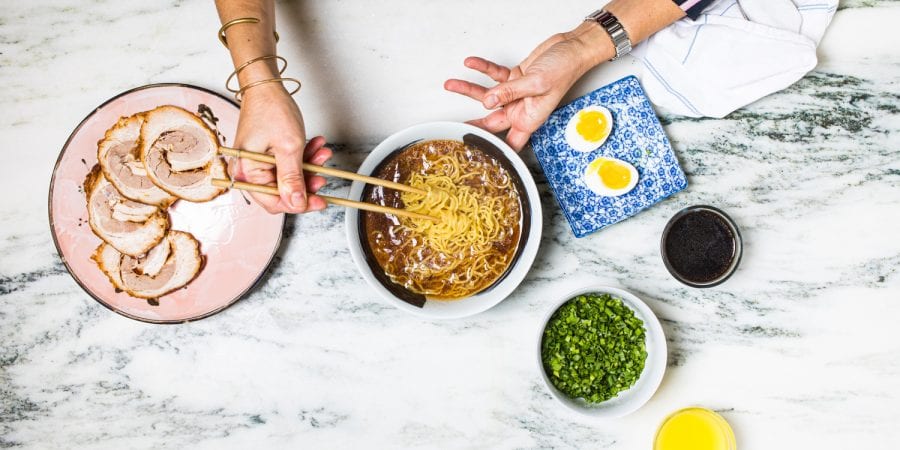Food Culture of the South
recipe 
yields
Serves 4
1 (5-8 pound) pork belly
1 piece skin-on ginger, cut into rough slices
3 star anise pods
4 tablespoons canola oil
1¼ cups soy sauce
1¼ cups mirin
1¼ cups sake
2 tablespoons sugar
Special equipment: Cheesecloth, butcher twine
4 cups sake
¼ cup sababushi atsukezuri (dried mackerel flakes)
¼ cup katsuobushi atsukezuri (dried bonito flakes)
15 grams kombu
2 tablespoons dried shiitake mushrooms
Special equipment: Attachable thermometer
2 cups sake dashi
2 tablespoons plus 1½ teaspoons rice vinegar
1 teaspoon kosher salt
1 tablespoon plus 1½ teaspoons cane sugar
2 cups soy sauce
1 (1-inch) piece kombu*
5 tablespoons sababushi atsukezuri*
5 tablespoons katsuobushi atsukezuri*
2 teaspoons sake kasu
Special equipment: Attachable thermometer
*You can substitute 2 packets of Japanese dashi powder in place of the kombu, sababushi, and katusobushi. Find them online or at your local Asian grocer.
4 slices chashu
2 cups greens, such as spinach, bok choy, mustard greens, or turnip greens
2 ramen eggs
4 tablespoons thinly sliced scallions (green parts only)
4 (1×4-inch) sheets roasted nori
8 tablespoons shoyu tare
4 tablespoons chicken fat (see chintan)
4 pinches ground white pepper
4 pinches ground katsuobushi
6 cups chintan
18 ounces fresh ramen noodles (or 12 ounces dried)
Chashu (Rolled Pork)
Sake Dashi
Shoyu Tare
For the toppings:
For the ramen:
steps
Chashu
- Cut pork in half to create two square pieces; roll tightly and secure with butcher twine. Wrap ginger and star anise in a piece of cheesecloth and tie with twine to create a sachet.
- Preheat oven to 350 degrees. In a pan over high heat, heat oil. Sear outside of pork belly roll, then transfer meat to a braising pan.

- In a medium saucepan over high heat, bring soy sauce, mirin, sake, ½ cup water, and sugar to a boil. Pour mixture over seared pork and add sachet. Braise pork for 45 minutes.
- Remove sachet and cover pan with aluminum foil. Reduce heat to 250 degrees and braise pork until tender, about 3 hours and 15 minutes more. Remove pork from pan and allow to cool, then transfer to refrigerator to cool completely before slicing.
Sake Dashi
In a large saucepan affixed with thermometer over medium-high heat, stir together all ingredients and bring to a light boil. Reduce the heat to maintain 190 degrees and let steep for one hour at that temperature. (Alternately, you can stir the ingredients together, let the mixture sit overnight, then bring to a boil and immediately remove from heat.) When the saba and katsuo no longer have a fishy flavor, the dashi is ready.
Shoyu Tare
- In a large stockpot affixed with thermometer over low heat, combine the sake dashi, rice vinegar, salt, sugar, and soy sauce. Without allowing the temperature to exceed 150 degrees, stir until the salt and sugar are dissolved, then remove pot from heat.
- Stir in kombu, sababushi, and katsuobushi. Allow the mixture to steep for up to 1 hour. Strain mixture, then stir in the sake kasu until it dissolves. The tare will keep for 2 weeks in the refrigerator or up to 12 months in the freezer.

Shoyu Ramen
- Prepare the toppings: Bring chashu to room temperature. In a large pot, bring 4 quarts of water to a boil. Prepare an ice bath. When the water is boiling, add greens and cook for about 30 seconds. Immediately transfer greens to ice bath, then pat dry. Cut leaves into 2-inch strips and set aside. Slice ramen eggs in half and set aside.
- Assemble the ramen: Fill a large pot three-quarters full with water, ideally with a strainer (or colander) that fits into it. Bring water to a boil over high heat. Meanwhile, make sure four serving bowls and all toppings are laid out for easy access. Place 2 tablespoons of tare, 1 tablespoon of fat, and 1 pinch each of pepper and katsuobushi in each bowl.
- In a second large pot affixed with a thermometer over medium heat, heat chintan broth to 190 degrees. Do not let the broth come to a boil.
- Cook noodles in boiling water according to package instructions, minus a few seconds. (Noodles will continue to cook in hot broth.) When noodles have about 30 seconds of cooking time left, ladle 1½ cups of broth into each bowl. When noodles are done, use chopsticks to divide them as evenly as possible among serving bowls, working as quickly as you can.
- Once noodles are in bowls, lightly stir them around so that the broth and fat evenly coat each noodle. Then, use chopsticks to grab as many noodles as possible, pull them upward out of the broth, and lay them flat across the top to create a sort of raft on which to lay the toppings.
- To each bowl, add a slice of chashu, blanched greens, half an egg, scallions, and a sheet of nori. Serve immediately.
From Otaku for Ramen.
share
- Recipe from Sarah Gavigan, Otaku Ramen, Nashville








